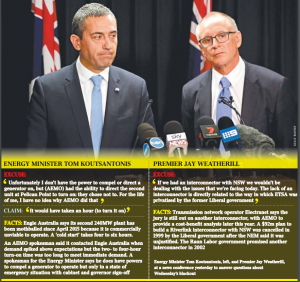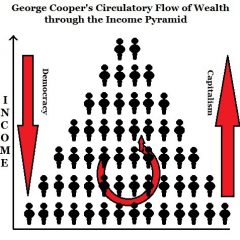The oversupply of wind-power has seen the question of “stable electricity supply” enter into public debate in Australia. It is now very urgent that Renewable Energy Certificates (REC) scheme be modified to make it work for the nation, rather than just for “Green Advocates.”
Excuses are not enough
Update 10 February 2017. Now we discover that the REC scheme is even causing gas fired generators to be turned off. This situation is ridiculous.

RECs undermining a stable electricity supply
Who would seriously contemplate implementing a scheme that encouraged wind-farm operators to produce electricity in the middle of the night, when it is not needed? The Australian government did, via the REC scheme, in 2000. Surely it is the responsibility of governments to implement policies that result in a stable electricity supply, not an unstable one!
Under the current REC scheme, wind-farms can even deliver electricity to the grid at a negative price, since this apparent loss can be offset by approximately $25 per MWh. This is currently the approximate rated proceeds for each certificate produced, whether the electricity generated is really needed for successful grid operation or not. The electricity retailers buy this undifferentiated certificate, since this helps them to meet their “renewable obligations,” and they have no need or way to differentiate such certificates for themselves.
The downside of this is approach is that coal-fired generators (and nuclear for that matter), cannot be affordably run if they have to be shut down every day because there is insufficient demand from the grid for the electricity they would generate during the night. Unlike a wind-farm, coal-fired generated cannot be just “run on idle,” since they need the back-force of generating the electricity to offset the fierce power of their steam-driven turbines. Yet Alinta’s Port Augusta coal fired generators were turned off at night, causing Alinta’s operation to be unprofitable, and therefore to be shut down forever.
Who would support a scheme that caused the former back-bone of the South Australian electricity supply market to be shut down prematurely, causing unemployment in Port Augusta, and for South Australian businesses to consider moving interstate? The South Australian Labor government did and still does.
It is ideological madness to continue with this short-sighted approach, involving undifferentiated “Certificates” that do not distinguish between the “no need” electricity pushed into the grid by wind-power during the night, and the truly “useful” electricity generated by wind-power during the day.
Did the South Australian government know that too much wind-power was already causing disruption to the electricity supply in 2011? Yes. That was when an academic study showed the problems in the supply situation and called for an upgrade to the high voltage inter-connector to Victorian brown-coal backup power, as a way to address the difficulties. (My 2012 comments on this report can be found here.) So the inter-connector was upgraded, which led to even more wind-farms being installed in South Australia. Folly, built upon folly.
Wind-power – a viable Renewable option
The risk to the wind-power project is palpable. Yet wind-farms (and nuclear – but who wants that after Chernobyl & Fukushima?) are the only current viable solution to the need for long-term renewable electricity supply.
Despite the support of the Greens & government funded ARENA, current generation solar is a mickey-mouse solution, only able to supply electricity economically at the household level, not at the grid level, with or without batteries, except during peak periods.
Of the ARENA funded solar projects, only the Genex proposal to use grid-supplied electricity to create pumped-hydro electricity makes sense. This is a Queensland project, a state where there is almost no wind-power, despite the Queensland government dreamland proposal for a rapid uptake of renewable energy.
Grid-supplied electricity, generated overnight and purchased from the grid for about $25 MWh, and sold back to the grid at $275 MWh can make good logical sense, provided the capital cost is not too high. Pumped-hydro will deliver a stable electricity supply. This particularly applies to wind-power, because most wind-power is generated at night, when the wind blows more strongly, but also when it is not needed. By utilizing pumped hydro, “unneeded” electricity can be stored over the whole night and then released during the day. Yet it is not happening. Obviously there needs to be a push to force governments and the wind-farm industry to utilize pumped hydro. This can be achieved just by encouraging the Australian government to tweak the REC scheme.
RECs & a stable electricity supply
(Updated 10 February 2017)
My proposal is that RECs should NOT be counted if the electricity is generated in off-peak periods (10 pm to 7 am). This will allow the market-distorting effect of undifferentiated RECs to be eliminated.
Excluding electricity generated during off-peak periods means that wind-power will not soak up all the available demand during the night. Therefore there will be sufficient demand for base-load generators to keep working all night, and that unnecessary, costly, inefficient, and high carbon-emitting shut-downs and start-ups will be avoided. While it may be too late for Alinta’s Pt Augusta plants to be re-instated, it could allow the remaining Victorian Latrobe Valley generators to keep working until there is sufficient wind + pumped hydro capacity to permit them to be finally and rationally phased out. It could also mean that Engie’s Pelikan Point facility could be kept running.
While the concept outlined here may be a challenge for Greens voters and politicians, they should get on board. It is the only currently viable approach to achieving the higher level of renewable energy generation that they would prefer. At least, if the current REC scheme is continued, they are likely to see the de-industrialization of South Australia, so perhaps they will rejoice over that!
Changes to the REC Targets
(Added 10 February, 2017)
In the Australian system, given the highly politicized nature of the debate on this subject, changes to the REC target are likely to be too difficult to implement. This applies even though such changes would be needed to effectively keep the current arrangements in place. Therefore, it is proposed that no change be made to the REC Targets, but rather that, after this scheme is implemented, renewable energy providers be allow to issue a REC for each 0.625 MWh generated (rather the current arrangement of 1 REC per 1 MWh).

One thought on “Stable Electricity Supply & RECs”